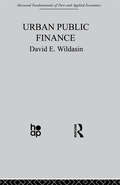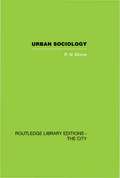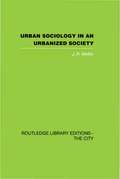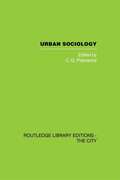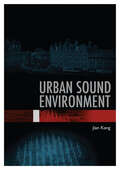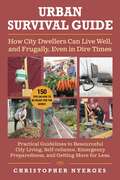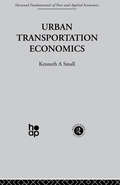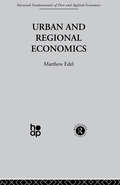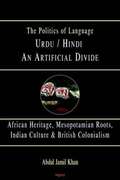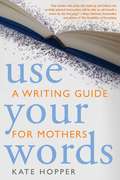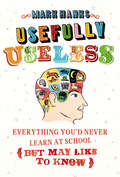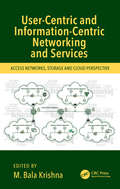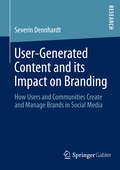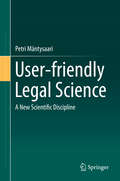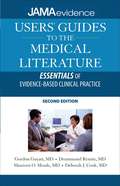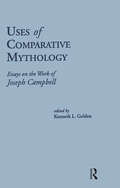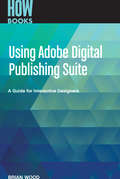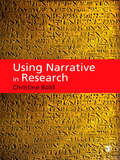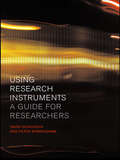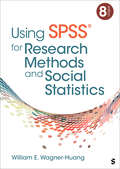- Table View
- List View
Urban Public Finance
by D. WildasinConsiders such issues as the effect of local government policies on migration, the optimal size of cities, tax and expenditure capitalization, the economics of intergovernmental transfers, tax exporting and tax competition.
Urban Sociology
by R.N. MorrisThis book offers a coherant theoretical introduction to urban sociology. Based on the urban theory of Louis Wirth, it systematically examines Wirth's principal ideas in the contexts of pre-industrial cities, industrial cities and bureaucracies. Morris discusses conditions for the emergence of cities and for industrialization. He relates organisational and ecological accounts of the city and considers the contributions of each. Bureaucracy appears as a peculiarly urban form of organisation: its ecological and social characteristics are examined in an original manner and with considerable insight so as to illustrate and modify the propositions derived from Wirth's theory. The book concludes with a comprehensive evaluation of Wirth and his critics. This book was first published in 1968.
Urban Sociology and Urbanized Society (International Library Of Sociology)
by J.R. MellorFocusing on urban sociology as practised in Britain, the author argues that it is a key element in the response of the 'intellectual proletariat' to urbanization and the calls on it by the State to control the ensuing way of life. The themes of urban sociology have been the concerns of the Welfare State and, despite radical inputs, the discipline has remained tied up with the assumptions and methodological precepts of liberalism. The author's contention is that urbanization should be analysed in the framework of the political economy of regional development. This book was first published in 1977.
Urban Sociology: Critical Essays
by C. G. PickvanceThis book applies the historical materialist, or Marxist view of urban sociology and collates some fundamental sources of this perspective available. This book was first published in 1976.
Urban Sound Environment
by Jian KangOver the past two decades there have been many major new developments in the field of urban sound environment. Jian Kang introduces and examines these key developments, including:the development of prediction methods for urban sound propagationestablishment and application of noise-mapping softwarenew noise control measures and design methods.Also
Urban Survival Guide: How City Dwellers Can Live Well, and Frugally, Even in Dire Times
by Christopher NyergesPractical Guidelines to Resourceful City Living, Self-reliance, Emergency Preparedness, and Getting More for Less A survival guidebook that reflects the world in which we now find ourselves. The post 9/11 world seems a bit more hostile, as terrorist threats and attacks are no longer a surprise. The Great Tsunami of Christmas 2004 showed us that quick extinctions (like Noah&’s flood) can and do happen without apparent warning. Hurricanes Katrina and Sandy not only told us that it can happen to us, but that it is foolhardy to make no preparations and pretend that the government will take care of you in the post-disaster landscape. The price of gold id rising again. War, rumors of war, famines, political instability, economic instability, global pandemics – all these and more are causes of concern to the average family. Economic survival is also addresses, since this is such a fundamental building block of everything else in modern society. Money cannot be ignored.
Urban Transportation Economics
by K. SmallThis title provides a comprehensive review of the economics of urban transportation.
Urban Water Cycle Processes and Interactions: Urban Water Series - UNESCO-IHP (Urban Water Series)
by Jiri MarsalekUrban Water Cycle Processes and Interactions represents the fruit of a project by UNESCO's International Hydrological Programme on this topic. The volume introduces the urban water cycle concept and the need for integrated or total management. It then explores in detail the manifold hydrological components of the cycle, the diverse elements of urban infrastructure and water services, and the various effects of urbanization on the environment - from the atmosphere and surface waters to wetlands, soils and groundwater, as well as biodiversity. A concluding series of recommendations for effective urban water management summarize the important findings set forth here.
Urban and Regional Economics: Marxist Perspectives (Fundamentals Of Pure And Applied Economics Ser.)
by M. EdelThis title discusses the treatment of urban and regional issues by Marx, Engels and other early Marxists, and examines recent controversies in these areas.
Urdu/Hindi: Evolution from African Genes, Mesopotamian Roots, and Indian Culture
by Abdul Jamil KhanThe lingua franca of the Indo-Pakistani people is one language, claims Khan, called Hindi when written in Nagari and Urdu when written in Arabic. He says it is not descended from Sanskrit, as conventionally believed, but is 10-12,000 years old and was influenced early by the Austric-Munda and Dravidian language families. Leaving aside any religious argument, he buttresses his theory with evidence from evolution, Sumerian, and the European concept of mythical races linked to linguistic families. His experience teaching pediatrics and infant speech development led him to the study of linguistics and history. Annotation ©2006 Book News, Inc. , Portland, OR (booknews. com)
Use Your Words
by Hope Edelman Kate HopperUSE YOUR WORDS introduces the art of creative nonfiction to women who want to give written expression to their lives as mothers. Written by award-winning teacher and writer, Kate Hopper, this book will help women find the heart of their writing, learn to use motherhood as a lens through which to write the world, and turn their motherhood stories into art. Each chapter of USE YOUR WORDS focuses on an element of craft and contains a lecture, a published essay, and writing exercises that will serve as jumping-off points for the readers' own writing. Chapter topics include: the importance of using concrete details, an overview of creative nonfiction as a genre, character development, voice, humor, tense and writing the "hard stuff," reflection and back-story, structure, revision, and publishing. The content of each lecture is aligned with the essay/poem in that chapter to help readers more easily grasp the elements of craft being discussed. Together the chapters provide a unique opportunity for mother writers to learn and grow as writers.USE YOUR WORDS takes the approach that creative writing can be taught, and this underscores each chapter. When students learn to read like writers, to notice how a piece is put together, and to question the choices a writer makes, they begin to think like writers. When they learn to ground their writing in concrete, sensory details and begin to understand how to create believable characters and realistic dialogue, their own writing improves. USE YOUR WORDS reflects Kate's style as a teacher, guiding the reader in a straightforward, nurturing, and passionate voice. As one student noted in a class evaluation: "Kate is a born writer and teacher, and her enthusiasm for essays about motherhood and for teaching the nuts and bolts of writing so that ordinary mothers have the tools to write their stories is a gift to the world. She is raising the value of motherhood in our society as she helps mothers build their confidence and strengthen their game as writers."
Use Your Words: A Writing Guide for Mothers
by Kate HopperUSE YOUR WORDS introduces the art of creative nonfiction to women who want to give written expression to their lives as mothers. Written by award-winning teacher and writer, Kate Hopper, this book will help women find the heart of their writing, learn to use motherhood as a lens through which to write the world, and turn their motherhood stories into art. Each chapter of USE YOUR WORDS focuses on an element of craft and contains a lecture, a published essay, and writing exercises that will serve as jumping-off points for the readers' own writing. Chapter topics include: the importance of using concrete details, an overview of creative nonfiction as a genre, character development, voice, humor, tense and writing the "hard stuff," reflection and back-story, structure, revision, and publishing. The content of each lecture is aligned with the essay/poem in that chapter to help readers more easily grasp the elements of craft being discussed. Together the chapters provide a unique opportunity for mother writers to learn and grow as writers. USE YOUR WORDS takes the approach that creative writing can be taught, and this underscores each chapter. When students learn to read like writers, to notice how a piece is put together, and to question the choices a writer makes, they begin to think like writers. When they learn to ground their writing in concrete, sensory details and begin to understand how to create believable characters and realistic dialogue, their own writing improves. USE YOUR WORDS reflects Kate's style as a teacher, guiding the reader in a straightforward, nurturing, and passionate voice. As one student noted in a class evaluation: "Kate is a born writer and teacher, and her enthusiasm for essays about motherhood and for teaching the nuts and bolts of writing so that ordinary mothers have the tools to write their stories is a gift to the world. She is raising the value of motherhood in our society as she helps mothers build their confidence and strengthen their game as writers."
Usefully Useless: Everything you'd Never Learn at School (But May Like to Know)
by Mark HanksUsefully Useless is a gloriously diverse volume dedicated to the most engrossing trivia in the world. Guaranteed to excite the curiosity and amuse, its pages are filled with the sort of remarkable information you would never learn, but will be overjoyed to discover. Each fact is irresistibly fun and fascinating - the essence of anecdote and dinner-party conversation that is essential in the adult world - and, above all, usefully useless. Guaranteed to improve your mind, Usefully Useless contains a wealth of miscellany on a vast range of topics, including Literature, Geography, Food, Science, the Natural World, Sport and Politics - from the export of frogs' legs to the longest Monopoly game completed in the bath. Usefully Useless provides answers to such eternal questions as:What was Margaret Thatcher's favourite sitcom?Which British league football team's name has no letters that one could colour in with a pen?How many calories do you consume when you lick a stamp?What was the original colour of Coca-Cola?Which key do toilets flush in?Find out these answers and many, many more in Usefully Useless, the essential guide to the facts you never thought you'd need to know.
User-Centric and Information-Centric Networking and Services: Access Networks, Storage and Cloud Perspective
by M. Bala KrishnaUser-Centric Networks (UCN) and Information-Centric Networks (ICN) are new communication paradigms to increase the efficiency of content delivery and also content availability. In this new concept, the network infrastructure actively contributes to content caching and distribution. This book presents the basic concepts of UCN and ICN, describes the main architecture proposals for these networks, and discusses the main challenges to their development. The book also looks at the current challenges for this concept, including naming, routing and caching on the network-core elements, several aspects of content security, user privacy, and practical issues in implementing UCN and ICN.
User-Generated Content and its Impact on Branding
by Severin DennhardtThe emergence of social media as one of the driving forces of consumers' online experiences today also challenges our current understanding on marketing and brand management. The effects of brands' social media involvement are to this day uncertain. Severin Dennhardt shows that social media and user-generated brands do have a strong influence on brands. Four independent studies demonstrate that first, successful brands can be created in virtual worlds, second, user-generated content drives the creation of unique brands, third social media strongly influences the social value perception of brands, and fourth, social media impacts consumers' purchase decision process.
User-friendly Legal Science
by Petri MäntysaariThis book defines the characteristics of a new discipline that is both legal and scientific: user-friendly legal science.Focusing on how legal tools and practices can be used to achieve objectives in different contexts, it offers an alternative to doctrinal research, law-and-something disciplines, and the traditional interdisciplinary approach.The book not only defines the new discipline’s research approach, point of view, theory-building, and research methods, it also shows how it relates to other scientific disciplines and how existing doctrinal legal disciplines can be upgraded into scientific disciplines.
Users' Guides to the Medical Literature: Essentials of Evidence-Based Clinical Practice (Second Edition)
by The Evidence-Based Medicine Working Group EditorsEvidence-based medicine involves the careful interpretation of medical studies and its clinical application. And no resource helps you do it better-and faster-than Users' Guides to the Medical Literature: Essentials of Evidence-Based Clinical Practice. This streamlined reference distills the most clinically-relevant coverage from the parent Users' Guide Manual into one highly-focused, portable resource. Praised for its clear explanations of detailed statistical and mathematical principles, The Essentials concisely covers all the basic concepts of evidence-based medicine--everything you need to deliver optimal patient care. It's a perfect at-a-glance source for busy clinicians and students, helping you distinguish between solid medical evidence and poor medical evidence, tailor evidence-based medicine for each patient, and much more. Now in its second edition, this carry-along quick reference is more clinically relevant--and more essential--than ever!
Uses of Comparative Mythology: Essays on the Work of Joseph Campbell (Routledge Library Editions: Myth Ser. #3)
by Kenneth L. GoldenThis collection, first published in 1992, offers critical-interpretive essays on various aspects of the work of Joseph Campbell (1904-1987), one of a very few international experts on myth. Joseph Campbell examines myths and mythologies from a comparative point of view, and he stresses those similarities among myths the world over as they suggest an existing, transcendent unity of all humankind. His interpretations foster an openness, even a generous appreciation of, all myths; and he attempts to generate a broad, sympathetic understanding of the role of these 'stories' in human history, in our present-day lives, and in the possibilities of our future.
Using Adobe Digital Publishing Suite
by Wood BrianUsing Adobe Digital Publishing Suite is for those who want to create apps for devices like iPad using Adobe InDesign and Adobe Digital Publishing Suite. In this book, we will cover the entire creation process from designing the app in InDesign to uploading it to an app store. The tips and notes along the way will give you extra insights or faster ways to do things, as well as help you avoid typical pitfalls.
Using Adobe Digital Publishing Suite: A Guide for Interactive Designers
by Wood BrianUsing Adobe Digital Publishing Suite is for those who want to create apps for devices like iPad using Adobe InDesign and Adobe Digital Publishing Suite. In this book, we will cover the entire creation process from designing the app in InDesign to uploading it to an app store. The tips and notes along the way will give you extra insights or faster ways to do things, as well as help you avoid typical pitfalls.
Using Android as a ‘Reading and a Writing Device’ - WBM (World Bank Modules)
by BookshareThis comprehensive document focuses on leveraging Android devices as efficient reading and writing tools for individuals with print disabilities, particularly visual impairments or dyslexia. It begins by detailing the setup and customization of TalkBack, the screen reader, elucidating settings, gestures, and keyboard shortcuts to enhance accessibility. Additionally, it covers the use of Magnification, enabling users to zoom in and out of the screen with tailored settings and gestures. The document introduces Dolphin EasyReader, a versatile reading app supporting various file formats like EPUB, Word, and audio books, offering synchronization, navigation, and customization features. It also guides users on writing in different languages through an external keyboard, providing options for phonetic or traditional typing methods. Furthermore, it delves into browsing the web using Chrome alongside TalkBack, emphasizing reading controls, keyboard shortcuts, and simplified view access for efficient web navigation. Complemented by video tutorials, resource links, and annexures, this document serves as a comprehensive guide, empowering individuals with print disabilities to maximize Android devices as effective tools for reading and writing.
Using Narrative in Research
by Christine BoldUsing Narrative in Research by Christine Bold provides an accessible, easy-to-understand guide to the theory and practice of the use of narrative in research. Written with those new to narrative in mind, this book will enable readers to understand the origins of narrative traditions and to plan and carry out a narrative study of their own. Christine Bold's book examines narrative approaches across a range of research contexts and disciplinary boundaries and will be of equal value to practitioners and academic students and researchers alike. Drawing on a range of real-life examples of narrative studies, Using Narrative in Research will enable readers to provide a sound justification for adopting a narrative-based approach and will help them to write about and write up narrative in research. This book examines: * How we design research projects with a narrative approach * Ethics * Narrative thinking * Collecting narrative data * Analysing narrative data * Representation in narrative analysis * Reporting and writing up narrative research.
Using Research Instruments: A Guide for Researchers (Routledge Study Guides)
by Peter Birmingham David WilkinsonClear, accessible and practical, this guide introduces the first-time researcher to the various instruments used in social research. It assesses a broad range of research instruments - from the well-established to the innovative - enabling readers to decide which are particularly well suited to their research.The book covers: questionnaires interviews content analysis focus groups observation researching the things people say and do. This book is particularly suitable for work-based and undergraduate researchers in education, social policy and social work, nursing and business administration. It draws numerous examples from actual research projects, which readers can adapt for their own purposes. Written in a fresh and jargon-free style, the book assumes no prior knowledge and is firmly rooted in the authors' own extensive research experience.Using Research Instruments is the ideal companion volume to The Researcher's Toolkit. Together they offer a superb practical introduction to conducting a social research project.
Using SPSS® for Research Methods and Social Statistics
by William E. Wagner-HuangThis is the perfect companion for students who are learning to use the SPSS software to interpret and manage data. Students will appreciate author William E. Wagner-Huang’s step-by-step explanations of SPSS operating procedures and introductory statistical operations. The Eighth Edition uses version 29 of the software and incorporates results from the 2022 General Social Survey (GSS) as a dataset used in examples throughout the book. In response to user feedback, the author has expanded the sections on ANOVA and chi-square. The GSS datasets and codebooks for use with the text are available on an accompanying website.
Using SPSS® for Research Methods and Social Statistics
by William E. Wagner-HuangThis is the perfect companion for students who are learning to use the SPSS software to interpret and manage data. Students will appreciate author William E. Wagner-Huang’s step-by-step explanations of SPSS operating procedures and introductory statistical operations. The Eighth Edition uses version 29 of the software and incorporates results from the 2022 General Social Survey (GSS) as a dataset used in examples throughout the book. In response to user feedback, the author has expanded the sections on ANOVA and chi-square. The GSS datasets and codebooks for use with the text are available on an accompanying website.
